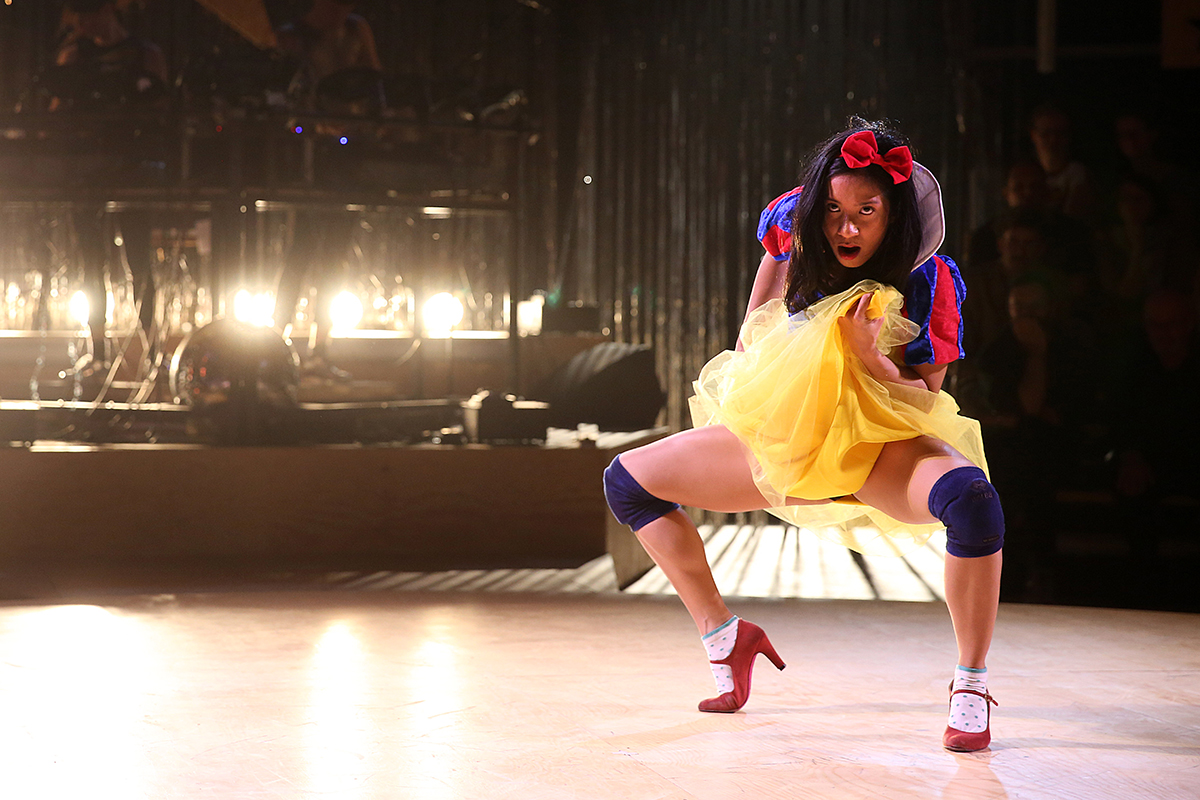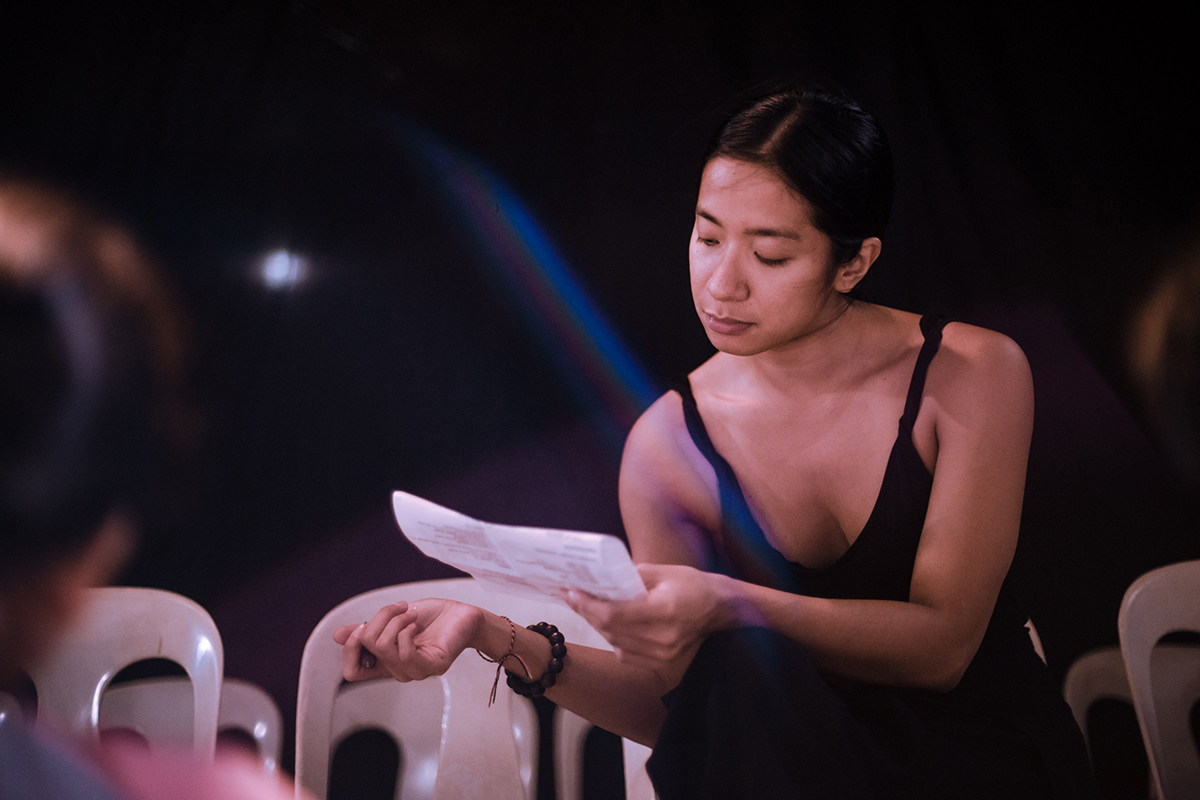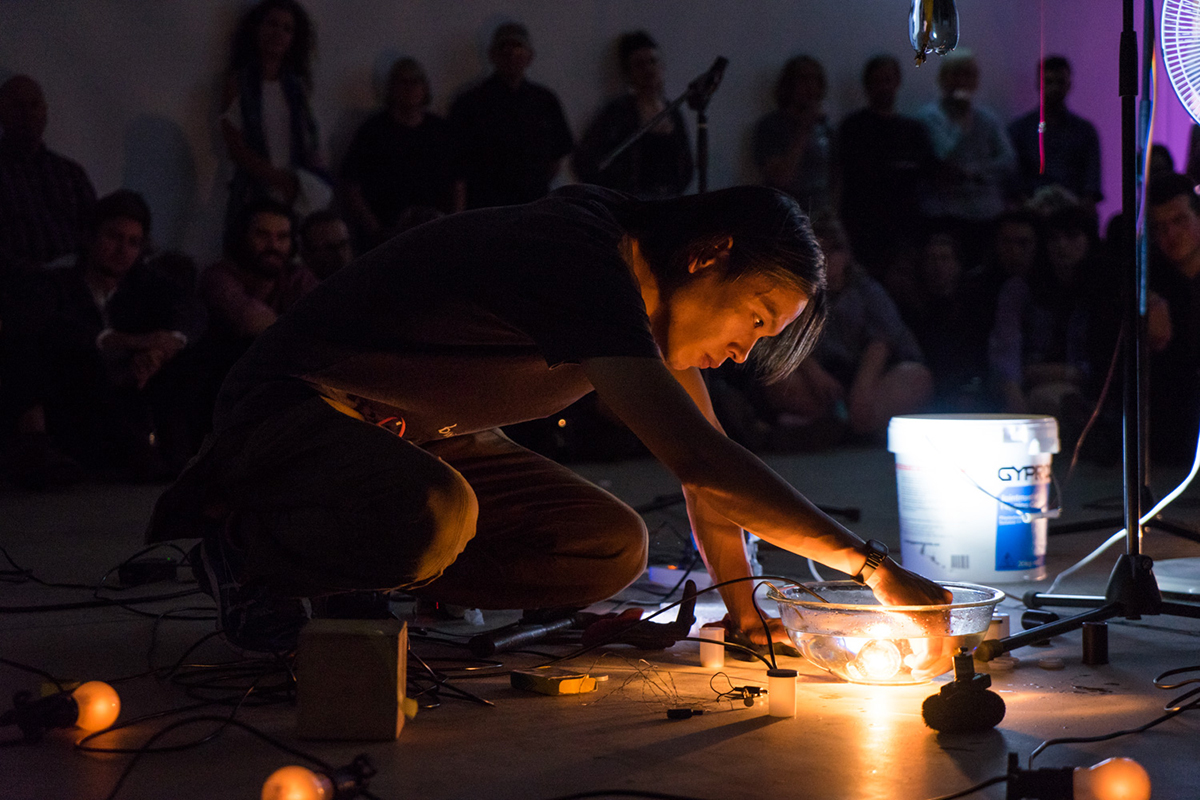
Liveworks: Tetsuya Umeda, Eisa Jocson: Process & experiment
The second week of Performance Space’s Liveworks had a more pervasive sense than the first of creative processes on show, experimentation and fascinatingly indeterminate outcomes. Next week, Cleo Mees will respond to Justin Shoulder’s remarkably inventive Carrion, and Nikki Heywood to Geumhyung Jeong’s challenging 7 Ways and the strangely enlightening Oil Pressure Vibrator.
One-on-one works yielded a strong sense of participants being intimately engaged in events quite out of the ordinary, if at the same time intricately tied to the everyday. Teik-Kim Pok experienced Jen Jamieson’s Let’s Make Love as “interactive biochemistry lecture, guided meditation and mini-date,” with each form now viewed from a new perspective. In Mark Harvey’s Helping Hand, Pok felt that the limits of everyday political conversation had been revealed by the amiable artist’s physical risk-taking. AEON, in which a number of participants and performers opt to engage in flocking behaviour, produced complex feelings and urges in Cleo Mees: “Questions thump in my chest: ‘What is happening? What will we all do? Also, what will I do? Will I run? Should I run? I really, really want to run.‘” The mark of each of these works, is the option for participants to decide the degree to which they will engage, although art’s seductiveness might well rule out a rational response.
Eisa Jocson’s Corponomy and Geumhyung Jeong’s Oil Pressure Vibrator were enlightening lecture demonstrations about process and vision. 7 Ways, which read like performance art staged as theatre and requiring the requisite audience patience, had the artist engaging erotically with everyday devices and sculpted heads given great agency via Jeong’s sometimes basic, sometimes virtuosic puppetry. Oil Pressure Vibrator revealed the artist’s astonishing rationale for her body of work with brief accounts of episodes seen in 7 Ways and, climactically, in a filmed work about her relationship with an industrial excavator.

Eisa Jocson, photo © Hiyas Bagabaldo courtesy Liveworks 2017
Eisa Jocson, Corponomy
Jocson, seen in a previous Liveworks, as well as in Adelaide’s OzAsia Festival and Melbourne’s Asia TOPA, exercises gently on the floor to one side of the stage, stretching limbs before standing, facing a large screen and then vibrating furiously. She stops and moves to a table on the other side of the stage where she sits at her computer triggering a scrolling text that lists her productions and reveals Corponomy to comprise ‘corpus’ and ‘economy’ — a coinage complementing the artist’s consistent preoccupation with exploitation of the body, especially among poor and migrant workers. She will also (in tandem with an offstage technician) trigger videos that reveal an artform that attracts her, herself being taught and mastering it, and a glimpse of the finished work. The videos are incrementally added until they collectively fill the screen. Until the final episode Jocson does not speak.
For Death of the Pole Dancer (2011) we see Jocson watching, learning, performing dextrously and then, in the highly abstracted finished work, moving slowly and sinuously before plunging dramatically down the pole. Onstage she puts on boots and engages in new exercises to prepare her body for Macho Dancer (2013) where we witness her onscreen observing the young men, often from poor backgrounds, who perform erotically for both men and women. Poster images of them in embrace or in the role of St Sebastian flicker by before we see Jocson being vigorously instructed and then, her musculature more pronounced, performing the resulting work. There’s reference to her Philippines Macho Dancing Academy and manual of 2014. Onstage Jocson echoes what we’ve seen onscreen, flexing and breathing emphatically, her body now that of a macho dancer.
Host (2015) addresses the role many Japanese women no longer wish to commercially enact and which Filipinos, female or transgender, will, often in Japanese guise. We see Jocson observing and being taught traditional dance with fan and umbrella by a Filipino transwoman entertainer, performing Filipino Sexbomb dancing and moving to K-pop. In an interview Jocson calls Host “a one-woman-entertainment-service-machine” with which she investigates “how these women negotiate their femininity, or their Filipino identity, in relation to the idea of the female-male identity in Japan.”
For the final episode of Corponomy, Happyland Part 1: Princess, Jocson gathers up her hair in a girlish bob with a red ribbon, slips on red shoes (but not the costume seen in the photograph from the actual production) and shows a scene from Walt Disney’s Snow White and the Seven Dwarfs, the excerpt opening with the princess saying to the dwarfs, “I didn’t mean to frighten you…I was afraid.” Jocson and another performer, her collaborator on the project, learn a song and choreography for the Snow White role but, as we are told, “In Disneyland Hong Kong, a legion of dancers from the Philippines are employed as professional entertainers to repeat formatted performances of ‘happiness’ as their daily labour. Excluded from the main roles reserved for specific racial profiles, they are assigned anonymous supporting roles.” In response, “two Filipino performers hijack the white-skinned princess, the archetypal model that dominates the narrative imagination of children while excluding their context, bodies and histories.”
Jocson becomes Snow White; adopting a cute falsetto and sweet giggle she moves among us, asking, “What’s your name?” and, in one instance, “What food do you like?” The answer, “Apple pie,” prompts the only near break in the facade: “I like adobo, which is chicken marinated in vinegar and soy sauce, and I miss it.” Jocson returns to the stage, gradually dismantling her role and becoming, among other things, the Macho Dancer, fake innocence turning muscular and ambiguously sexual as her version of herself and the words, “I didn’t mean to frighten you…” ever so slowly fade. It’s a chillingly triumphant conclusion.
Jocson’s commitment to researching and coming to understand the economic necessities that can drive art-making and, in some forms, the exploitation of that human capacity, is palpably felt because she is willing to embody and, where necessary, critique those practices. Corponomy is an admirable summing up of an evolving body of work, adroitly constructed to delineate the subject, the body regime, the learning, the work, and, not least, though few words are spoken, the thinking and its incisive delvery, as in the interview cited above: “The entrenchment of American culture in the psyche of the Filipino people has produced disciplined bodies suitable for affective labour in the happiness empire.”

Tetsuya Umeda, RINGO, Room 40 presentation at IMA, Brisbane, photo Louis Lim courtesy Liveworks 2017
Tetsuya Umeda, Ringo
Compared with Eisa Jocson, who finds and fashions movement forms she has encountered and which intrigue her politically, and Geumhyung Jeong, who anthropomorphises domestic and industrial devices to calculatedly erotic and self-transformative ends, Osaka-based sound artist Tetsuya Umeda is an artist whose work brings to mind Alexander Calder’s dictum on abstract art: “This has no utility and has no meaning, it is simply beautiful. It has great emotional effect if you understand it. Of course, if it it meant anything it would be easier to understand, but it would not be worthwhile.”
An apparent experimenter, Umeda is an artist at work in his lab — the space we share with him. Expressionless, casually attired, tool belt around his waist, he restlessly manipulates the lights, objects, liquids, wiring, switches and strange devices littered about the floor. When not triggering or layering sounds or setting up for cause and effect (adding liquid or chemicals or a tiny microphone to containers), he’ll occasionally step back from the attention-demanding minutiae to gauge the space or the evolution of his sono-kinetic creation. Early on he generates a big picture by hoisting high a partly filled, spinning plastic water bottle, angling light to project it onto a wall, later adjusting it so the image becomes a huge abstract whirlpool. Umeda persistently balances small aural and visual detail with his overarching building of a sculpted space and a musical composition.
On the floor are littered myriad devices including small gas cookers, buckets, rubbish bins, conjoined tin cans, a wine bottle, a large hollow glass ball, a car battery and a block of dry ice, which Umeda chisels and hammers. He casually strokes a thin metal pole releasing high harmonics and by turning the pole rapidly in the dry ice block unleashes an elephantine trumpeting. Ringo is full of such surprises — unusual sounds from unlikely sources — some short-lived, some enduring and accumulative, building texture and structure. A suspended horn speaker with a small screen attached picks up a voice which gradually becomes chant-like, growing deeper and increasingly guttural, yielding a persistent sense of ritual.
As Umeda moves among his devices, he takes precautions, puts on gloves (if not always with the dry ice) and mops spilled liquids, enhancing the sense of risk and experiment (and playing the audience with a repeated party trick). Lighting flickers inexplicably. Some things look risky, but are doubtless not. In dimmed light, Umeda adds more and more water to the glass ball, which has within it a pulsing, glowing filament. Reaching in, he places a small device, a microphone perhaps, at the base, instantly triggering a vigorous boiling motion and corresponding burbling. It’s a memorable image in a work with many striking moments, small and large, and an arc that moves from quiet subtleties to a climactic passage — the voice agitated, siren ringing, horn trumpeting and a deep pulsing, from who knows where. It completes itself with a long, sustained, grainy note, interrupted by odd outbursts of cracked dialogue. Umeda switches on the room lights. Illusion over.
Though an improvised composition with many instrumental variables, Ringo has a pleasing cogency, as does the overall audio-visual shaping of the performance: fluent, cumulative and reforming organically after absorbing a plethora of surprises. Tetsuya Umeda is a humble magician, trickster, visual artist, sound artist, composer and ritualist of the everyday.
The extent to which Ringo is experimental, given that its form is of a kind Umeda has used regularly and travelled widely with, depends on the performance spaces he must adjust to, new elements and devices he chooses to add to his collection, and the inevitable variables introduced by often lo-fi devices that are not necessarily stable. The work seems more improvisational than strictly experimental, the outcome broadly predictable, but full of invention and potential in its detail. It’s interesting to note that in other works Umeda has collaborated with the faux violent ensemble contact Gonzo who tussle around his music-making and a large scale work in Korea that includes strings, brass and architectonic lighting. It would be good to see more of his work in Australia.
Tetsuya Umeda is staging an exhibition at Melbourne’s The Substation until Saturday 4 November and will perform on Friday 3 November.
–
Performance Space, Liveworks Festival of Experimental Art: Corponomy, Eisa Jocson, 22 Oct; Ringo, Tetsuya Umeda, 25-28; Carriageworks, Sydney
Top image credit: Eisa Jocson, Happyland Part 1: Princess, in The Greatest Show, photo © Anja Beutler courtesy Liveworks 2017






